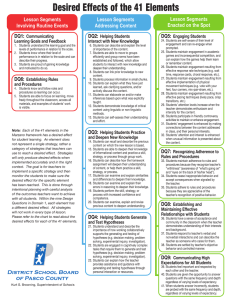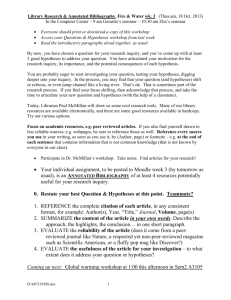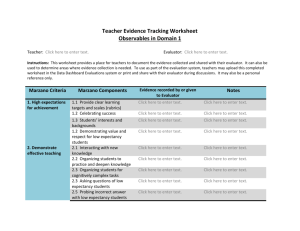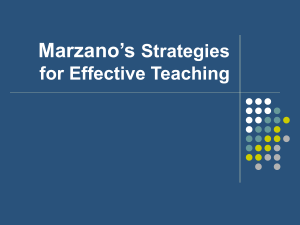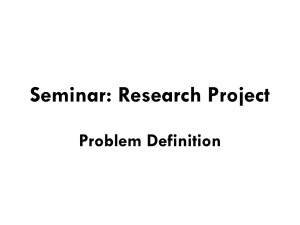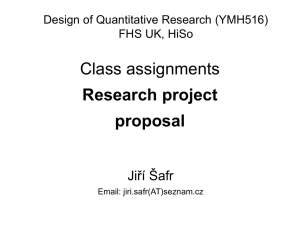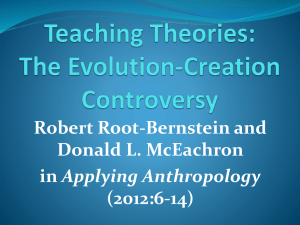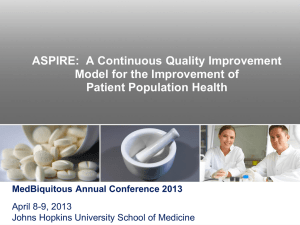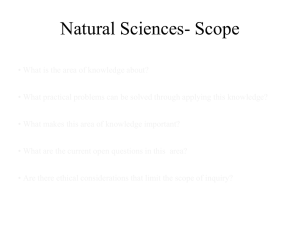Engaged Learners
advertisement
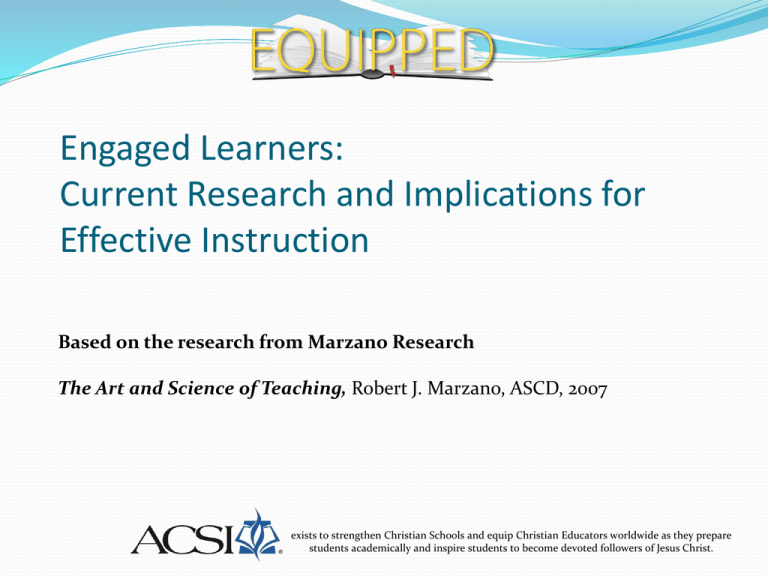
Engaged Learners: Current Research and Implications for Effective Instruction Based on the research from Marzano Research The Art and Science of Teaching, Robert J. Marzano, ASCD, 2007 exists to strengthen Christian Schools and equip Christian Educators worldwide as they prepare students academically and inspire students to become devoted followers of Jesus Christ. A Comprehensive Framework for Effective Instruction: Ten Questions What will I do to establish and communicate learning goals, track student progress, and celebrate success? 2. What will I do to help students effectively interact with new knowledge? 3. What will I do to help students practice and deepen their understanding of new knowledge? 4. What will I do to help students generate and test hypotheses about new knowledge? 1. Framework 10 Questions, con’t. 5. What will I do to engage students? 6. What will I do to establish or maintain classroom rules and procedures? 7. What will I do to recognize and acknowledge adherence and lack of adherence to classroom rules and procedures? 8. What will I do to establish and maintain effective relationships with students? 9. What will I do to communicate high expectations for all students? 10. What will I do to develop effective lessons organized into a cohesive unit? Research Results for Goal Setting Synthesis Study Focus Number of Effect Sizes Average Percentile Effect Size Gain Wise & Okey, 1983 General effects of setting goals 25 0.48 18 Lipsey & Wilson, 1993 General effects of setting goals 204 0.55 21 21 o.40 16 Walberg, 1999 General effects of setting goals 1. What will I do to establish and communicate learning goals, track student progress, and celebrate success? Make a distinction between learning goals and learning activities or assignments. Students will successfully complete the exercises in the back of Chapter 3. Students will create a metaphor representing the food pyramid. Students will be able to determine subject/verb agreement in a variety of simple, compound, and complete sentences. Students will understand the defining characteristics of fables, fairy tales, and tall tales. Students will investigate the relationship between speed of air flow and lift provided by an airplane wing. 1. What will I do to establish and communicate learning goals, track student progress, and celebrate success? Write a rubric or scale for each learning goal. Simplified Scale or Rubric 4.0 In addition to score 3.0, in-depth inferences and applications that go beyond what was taught. 3.0 No major errors or omissions regarding any of the information and/or processes (simple or complex) that were explicitly taught. 2.0 No major errors or omissions regarding the simpler details and processes but errors or omissions regarding the more complex ideas and processes. 1.0 With help, a partial understanding of some of the simpler details and processes. 0.0 Even with help, no understanding or skill demonstrated. 1. What will I do to establish and communicate learning goals …..con’t. Have students identify their own learning goals. Assess students using a formative approach. Formative assessments are used while students are learning new content - provides measurement, can be an instructional tool, students can observe their own progress. Have students chart their own progress on each learning goal. Recognize and celebrate growth. 2. What will I do to help students effectively interact with new knowledge? Critical-input experiences, previewing, “small chunks”, summarizing and note taking, graphic organizers, mnemonic strategies, questioning, reflecting, cooperative learning …… 1. Identify critical-input experiences. (Single out a few well-structured input experiences to achieve that goal.) 2. Preview the content prior to a critical-input experience. (What do you think you know about ..) 3. Organize students into groups to enhance the processing of information. (with clear operating rules) 4. Present new information in small chunks and ask for descriptions, discussion, and predictions. (Identify strategic stopping points and use ABC group summary) 5. Ask questions that require students to elaborate on information. 6. Have students write out their conclusions or represent their learning non-linguistically. (notes, graphic organizers, etc.) 7. Have students reflect on their learning. 3. What will I do to help students practice and deepen their understanding of new knowledge? Difference between procedural knowledge (skills, strategies, or processes) and declarative knowledge (information). Procedural takes practice … Provide students with tasks that require them to examine similarities and differences. Help students identify errors in thinking. Provide opportunities for students to practice skills, strategies, and processes. Determine the extent to which cooperative groups will be used. Assign purposeful homework that involves appropriate participation from home. Homework that helps students deepen their knowledge Homework that enhances students fluency with procedural knowledge Homework that introduces new content Have students systematically revise and make corrections in their academic notebooks. 4. What will I do to help students generate and test hypotheses about new knowledge? Problem based learning; generating and testing of hypotheses …. Teach students about effective support Engage students in experimental inquiry tasks that require them to generate and test hypotheses Engage students in problem-solving tasks that require them to generate and test hypotheses. Engage students in decision-making tasks that require them to generate and test hypotheses. Have students design their own tasks Consider the extent to which cooperative learning structures will be used 5. What will I do to engage students? Engagement means student attending to the instructional activities in class (questions, missing information, mild pressure, mild controversy and competition) Use games that focus on academic content Use inconsequential competition (fun) Manage questions and response rates (pause is good) Use appropriate pacing Demonstrate intensity and enthusiasm for content Engage students in friendly controversy Provide opportunities for students to talk about themselves Provide unusual information 6. What will I do to establish or maintain classroom rules and procedures? Organize the classroom for effective teaching and learning Establish a small set of rules and procedures Interact with students about classroom rules and procedures Periodically review rules and procedures, making changes as necessary Use classroom meetings 7. What will I do to recognize and acknowledge adherence and lack of adherence to classroom rules and procedures? Use simple verbal and nonverbal acknowledgement Use tangible recognition when appropriate Involve the home in recognition of positive behavior Strategies to use with “lack of adherence” Be with it – awareness and quick attention, move around the room, confronting when needed, etc. Use direct cost consequences (explicit and concrete) Use group contingency (you are in this together) Use home contingency (we are in this together) Have a strategy for high intensity situations Design an overall plan for discipline 8. What will I do to establish and maintain effective relationships with students? Both concern and cooperation; guidance and control Know something about each student Engage in behaviors that indicate affection for each student Bring student interests into the content and personalize learning activities Engage in physical behaviors that communicate interest in students (smile, look in the eyes) Use humor when appropriate Consistently enforce positive and negative consequences Project a sense of emotional objectivity Maintain a cool exterior 9. What will I do to communicate high expectations for all students? Identify you expectation levels for students Identify differential treatment of low expectancy students Make sure low expectancy students receive verbal and nonverbal indications that they are valued and respected. Ask questions of low expectancy students; stay with them 10. What will I do to develop effective lessons organized into a cohesive unit? Identify the focus of a unit of instruction Plan for lesson segments that will be routine components of every lesson (Hunter’s lesson design) Plan for content specific lesson segments Plan for actions that must be taken on the spot. Develop a flexible draft of daily activities for a unit Review the critical aspects of effective teaching daily
